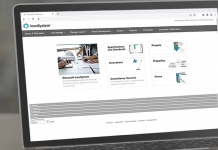Jason Ruddle, COO at Elecosoft examines how far BIM Level 2 has come regarding unification and collaboration throughout the construction industry.
Bringing the complex and disparate design and construction sector together into a more unified, collaborative and effective value chain was one of the original aims of BIM – now, some five years on from the start of the government’s original countdown, how far has that aim been achieved?
Industry and professional bodies from RIBA to RICS, NBS to CIOB and the BIFM have all, quite understandably, focused on tracking the adoption of BIM within their own areas. Meanwhile, though, nobody has really looked at whether BIM is doing the job of creating a more integrated community.
There seems an assumption that if BIM is happening, so is collaboration and information sharing – but those are not quite the same. The recent 2016 NBS National BIM Report survey tells us that only 37% of those surveyed are using BIM from the start of a project to the very end, with only just over half (54%) of all respondents saying they are using BIM.
Our role has been as a facilitator and enabler of BIM from the outset, as we reshaped our own project management tool, Asta Powerproject, to fit a BIM-centric future. In the past five years, we have enormously expanded our focus from project planning to 4D BIM and onwards to 5D BIM – and we have come to a conclusion: an integrated view of projects from start to finish is a prerequisite for an integrated construction community.
The power of an integrated view
It is in the very nature of construction and engineering design to explore extremes and try to achieve bigger and greater things. Many construction projects are getting larger and more complex. From bridges that span longer distances to ever-higher skyscrapers, each requires the utmost in collaboration and information sharing. Every party to the development needs to be involved from day one and maintain their visibility throughout the construction to keep everything in balance.
Doing this without a single shared view of the project is nearly impossible. This is why project planning and management solutions, which have always been the mainstay of keeping projects on track, have expanded their role so significantly. Bringing 3D design together with project planning and management created the first integrated view for BIM – adding time to the 3-dimensional world of construction planning to create 4D BIM. It marked the start of the construction community coming together. It brought together architects, engineers and building designers with those tasked to put brick on brick. This fourth dimension means that everyone involved can extract and visualize the progress of their activities through the lifetime of each project. 5D BIM is now emerging in earnest. Our own work to integrate our cost management system, Bidcon, with our 4D solution created an even more powerful integrated view. This, effectively, enables cost estimators and quantity surveyors to act as a part of the core BIM team for the first time, adding not only their information but their cost control expertise. It results in much tighter cost management overall, with the ability to respond quickly to price changes and provide better cost reporting to stakeholders. This, in turn, drives more informed decision-making. 5D BIM technology brings about much greater accuracy in evaluating scenarios and “what if?” change impacts such as materials or manpower changes as well as the ability to extract and analyse costs throughout the entire project lifecycle.
Increased collaboration
While contractors are still grappling with the mandate for Level 2 BIM, which came into effect for public projects on 4th April this year, our customers are telling us increasingly that what they need is better collaboration that goes beyond these government- defined standards. They are seeking a more integrated view to bring together the many layers of people that work on each construction project, as well as to drive efficiencies, and talk is now moving from just being about BIM to a wider term of digital construction
As the government now starts to look towards Level 3 BIM, its focus is expanding to include building owners and operators, along with facilities maintenance and building services professionals. It means that “6D BIM” is in active discussion – although this is less about an integrated view than continuity of view.
It will depend upon the seamless transfer of information out of the 5D BIM construction process into onward management systems such as Computer Aided Facilities Management (CAFM) solutions. Here the value of BIM will be felt by owners and operators, as rich information will support the integrated view of a living, working building. For FM, this means easier issues locating, and the ability to improve budgeting as well as the ability to schedule repairs and replacements for facilities like boilers or lifts.
For owners, it will mean more cost effective asset management and enable better environmental management and compliance, feeding data into Building Environmental Management solutions (BEMs).
The BIM mandate alone was never going to be sufficient to achieve full cross-functional construction collaboration, but it is nonetheless proving effective at sharpening up the industry’s performance. Increasingly, the introduction of digital technology and a new breed of construction professionals is slowly breaking down barriers to information visibility, as well as enabling information exchange for all involved in a project. BIM gives us a great opportunity to bring many people together. It’s time we embraced that.
Jason Ruddle has more than 25 years’ experience in the construction industry delivering key software solutions, products, and services to national housebuilders, contractors, and the supply chain. He is a highly experienced construction software specialist with a background spanning training, sales and business leadership and has a reputation among his colleagues for having a sound and common sense towards embracing change by adopting and delivering technology. Today he is COO of Elecosoft plc, a leading international developer of project, portfolio, resource management and BIM software including its flagship digital construction product: Asta Powerproject.
Jason Ruddle
Chief Operating Officer
Elecosoft
info@elecosoft.com
www.astapowerproject.com
Twitter @astapmsoftware













